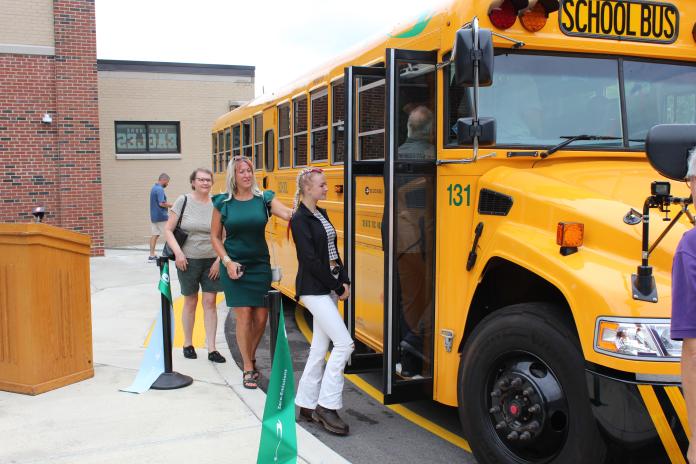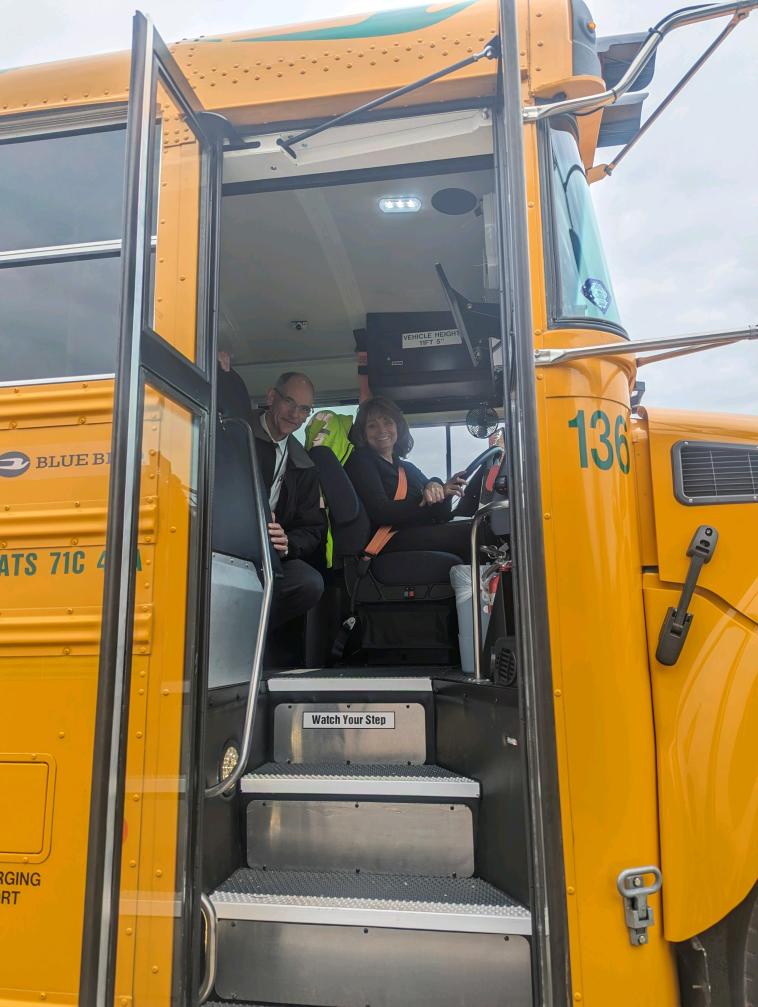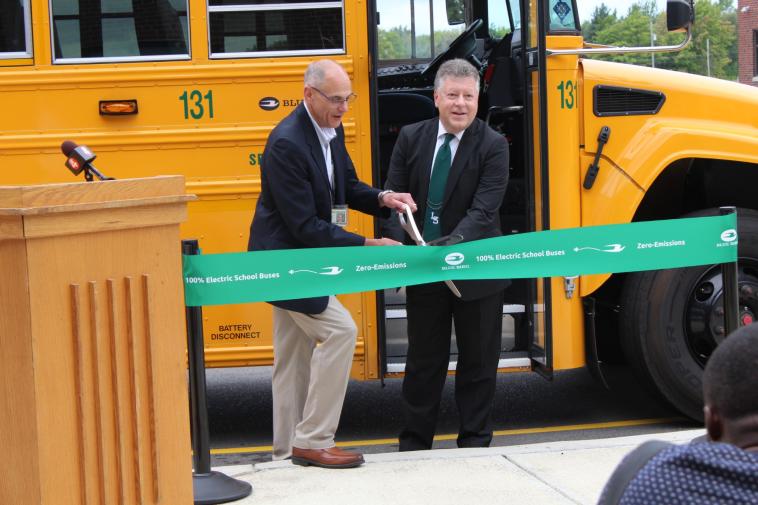How a Western New York School District Energized a Community Around Electric School Buses
In the cold winters near Buffalo, one school district is successfully deploying an electric school bus on its longest route – and saving money!

The Electric School Bus Series shows how superintendents and fleet managers across the United States have pursued school bus electrification in their own communities. This edition covers Lake Shore Central School District, a district in western New York that has successfully adopted electric school buses by engaging the community. This article is based on an interview with Perry Oddi, Transportation Supervisor, and Lori Raphael, bus driver, of Lake Shore Central School District.
Introduction
Just off the shores of Lake Erie near Buffalo, New York, sits Lake Shore Central School District, serving 2,200 students across five schools. Amidst the harsh winters of western New York, Lake Shore has begun electrifying its school bus fleet through innovative community engagement efforts and is now running a successful pilot program. The district currently operates two electric school buses (ESBs) and has 20 more joining its fleet soon, delivering a healthier, more comfortable ride for students and drivers, along with cost savings for the district.
| Lake Shore Central School District | |
| Location | Erie County, NY (near Buffalo) |
| Number of students | 2,200 students |
| Number of schools | 5 schools |
| Percentage of students who ride the bus | 92% school transportation ridership |
| Fleet size | 46 total school buses |
| Number of electric school buses in fleet | 2 electric school buses operating; expecting an additional 20 electric school buses to join the fleet |
 | |
Why Lake Shore chose electric school buses
Lake Shore’s interest in ESBs began in April 2019 when the district started to look at alternative fuel sources to diesel and gasoline as an extension of their broader sustainability efforts. Perry Oddi, the district’s Transportation Supervisor, emphasizes that “clean air, clean water and clean soil” are “really important to us as a district,” which prompted interest in spearheading a number of sustainable projects including ESBs, which produce zero tailpipe emissions of the harmful pollutants that diesel-burning school buses spew.
The electric school buses have an operating range of up to 122 miles per charge, allowing the district to easily meet all its transportation needs.
The district worked with their school bus manufacturer, Blue Bird, to bring an ESB to the district for the transportation department to experience, along with key stakeholders, including school board members, the superintendent, the assistant superintendent, the business manager and transportation directors from other districts across western New York. Through this early and extensive engagement with key stakeholders, Lake Shore was able to facilitate broader support for ESBs once they began examining funding options to make the transition a reality.
New York has set a nation-leading requirement for all school buses to be clean-running electric school buses by 2035. This was one of the motivations for Lake Shore’s transition as they started to realize that it was a question of how, not if the district would transition to electric school buses.

Partners and Advocates
With the buy-in from district leaders, in 2021 Lake Shore applied for and received funding for one electric school bus through the New York Truck Voucher Incentive Program. This first ESB was put into service in the fall of 2022 and served the district’s longest route, meeting the disadvantaged community requirement of the funding program. Ahead of deployment, the district held a ribbon-cutting ceremony in August with public ride and drives to celebrate its arrival, giving community members the opportunity to experience the benefits of ESBs firsthand.
In September 2023, Lake Shore received a second ESB that was publicly funded through a local referendum. When its second ESB was delivered, the district held an all-day themed “electric day” at the elementary school where the new ESB would be put into service. The school principal hosted a contest for students to envision the future of the electric school bus and once again provided opportunities for students, staff, and the community to ride and experience the ESB. Students even had the chance to dance the electric slide to celebrate the arrival of their tailpipe-emissions-free electric school bus.

Lake Shore also aligned its day-long event with their Alumni Basketball game, the district’s most well-attended annual event, further extending their reach and visibility to the community. Oddi believes that these engagement efforts were important because they allowed them to showcase the benefits of ESBs directly to community members who may not have otherwise known about the efforts, which eventually helped lead to voter approval for further ESB funding.
What’s the latest?
Students, drivers and community members in Lake Shore have been impressed by how well ESBs have performed and how they deliver a quieter, more comfortable ride than diesel-burning school buses.
Lori Raphael, who had been a bus attendant with the district for seven years, decided to become a bus driver after the district received its first ESB because she was so impressed by the bus. She realized that if “this was the future, I wanted to be a part of it” and has observed that the acceleration and regenerative braking in the ESBs are great, making it easier to merge with traffic and allowing for smoother stops when compared to diesel-burning school buses. The students also prefer the ESBs and appreciate how they are quieter and smell better than diesel-burning school buses.
Lori Raphael, who had been a bus attendant with the district for seven years, decided to become a bus driver after the district received its first ESB because she was so impressed by the electric school bus.
Lake Shore’s ESBs have operated just as well as their diesel-burning counterparts, including in freezing temperatures during New York’s winter months. Raphael has been impressed by how comfortable the cabin temperature is even on the coldest days. She observes, “you almost get instant heat in an ESB” whereas diesel-burning school buses “take a while for the heater to rev up and make the cabin comfortable.” Lake Shore’s ESBs use a thermal management system to control cabin temperature and do not utilize an auxiliary diesel heater.
The district operates one of its ESBs on its longest route, which runs 55 miles, and the other ESB on a route that runs through downtown Angola, the largest community in the district. The electric school buses have an operating range of up to 122 miles per charge, allowing the district to easily meet all its transportation needs.
An additional benefit to transitioning to ESBs has been the substantial cost savings for the district, as electricity is significantly cheaper than diesel, and ESBs require less maintenance than diesel-burning school buses. Oddi estimates that a route operated by a diesel-burning school bus would cost about $22, while an equivalent route operated by an ESB would cost less than $4, delivering approximately $15,000 of cost savings per school bus each year. Lake Shore was recently awarded a Clean School Bus Program grant, which will enable the district to purchase 20 more ESBs, delivering a cleaner ride for more students and drivers.
By electrifying their fleet, Lake Shore is expecting to save $15,000 per school bus on fuel each year.
Advice for Other School Districts
Lake Shore’s electrification process has been successful largely because of their thoughtful and inclusive efforts to engage their community early on, and their ability to inspire students, drivers and other stakeholders to be excited about the benefits of ESBs. Community buy-in is critical to the success of any initiative and Lake Shore serves as a model for other districts considering electrification.
Oddi encourages other districts to do their research to understand all available funding options, and to look at products and partners, emphasizing the importance of partnering with the right manufacturers to help your district make thoughtful choices. Lake Shore facilitates continuous training for drivers and mechanics, to ensure the safety of ESB operations, and encourages other districts to do the same.